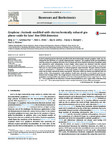Graphene electrode modified with electrochemically reduced graphene oxide for label-free DNA detection
| dc.contributor.author | Li, B | |
| dc.contributor.author | Pan, G | |
| dc.contributor.author | Avent, ND | |
| dc.contributor.author | Lowry, RB | |
| dc.contributor.author | Madgett, TE | |
| dc.contributor.author | Waines, PL | |
| dc.date.accessioned | 2015-10-02T10:24:27Z | |
| dc.date.accessioned | 2016-10-04T10:00:40Z | |
| dc.date.available | 2015-10-02T10:24:27Z | |
| dc.date.available | 2016-10-04T10:00:40Z | |
| dc.date.issued | 2015-10 | |
| dc.identifier.issn | 0956-5663 | |
| dc.identifier.issn | 1873-4235 | |
| dc.identifier.uri | http://hdl.handle.net/10026.1/5552 | |
| dc.description.abstract |
A novel printed graphene electrode modified with electrochemically reduced graphene oxide was developed for the detection of a specific oligonucleotide sequence. The graphene oxide was immobilized onto the surface of a graphene electrode via π-π bonds and electrochemical reduction of graphene oxide was achieved by cyclic voltammetry. A much higher redox current was observed from the reduced graphene oxide-graphene double-layer electrode, a 42% and 36.7% increase, respectively, in comparison with that of a bare printed graphene or reduced graphene oxide electrode. The good electron transfer activity is attributed to a combination of the large number of electroactive sites in reduced graphene oxide and the high conductivity nature of graphene. The probe ssDNA was further immobilized onto the surface of the reduced graphene oxide-graphene double-layer electrode via π-π bonds and then hybridized with its target cDNA. The change of peak current due to the hybridized dsDNA could be used for quantitative sensing of DNA concentration. It has been demonstrated that a linear range from 10(-7)M to 10(-12)M is achievable for the detection of human immunodeficiency virus 1 gene with a detection limit of 1.58 × 10(-13)M as determined by three times standard deviation of zero DNA concentration. | |
| dc.format.extent | 313-319 | |
| dc.format.medium | Print-Electronic | |
| dc.language | en | |
| dc.language.iso | eng | |
| dc.publisher | Elsevier BV | |
| dc.relation.replaces | http://hdl.handle.net/10026.1/3564 | |
| dc.relation.replaces | 10026.1/3564 | |
| dc.subject | Grapheme | |
| dc.subject | Electrochemically reduced graphene oxide | |
| dc.subject | Electrochemical sensor | |
| dc.subject | Label-free DNA detection | |
| dc.title | Graphene electrode modified with electrochemically reduced graphene oxide for label-free DNA detection | |
| dc.type | journal-article | |
| dc.type | Article | |
| plymouth.author-url | https://www.ncbi.nlm.nih.gov/pubmed/26002015 | |
| plymouth.volume | 72 | |
| plymouth.publication-status | Published | |
| plymouth.journal | Biosensors and Bioelectronics | |
| dc.identifier.doi | 10.1016/j.bios.2015.05.034 | |
| plymouth.organisational-group | /Plymouth | |
| plymouth.organisational-group | /Plymouth/Faculty of Health | |
| plymouth.organisational-group | /Plymouth/Faculty of Health/School of Biomedical Sciences | |
| plymouth.organisational-group | /Plymouth/Faculty of Science and Engineering | |
| plymouth.organisational-group | /Plymouth/Faculty of Science and Engineering/School of Engineering, Computing and Mathematics | |
| plymouth.organisational-group | /Plymouth/Faculty of Science and Engineering/School of Geography, Earth and Environmental Sciences | |
| plymouth.organisational-group | /Plymouth/REF 2021 Researchers by UoA | |
| plymouth.organisational-group | /Plymouth/REF 2021 Researchers by UoA/UoA01 Clinical Medicine | |
| plymouth.organisational-group | /Plymouth/REF 2021 Researchers by UoA/UoA01 Clinical Medicine/UoA01 Clinical Medicine | |
| plymouth.organisational-group | /Plymouth/REF 2021 Researchers by UoA/UoA12 Engineering | |
| plymouth.organisational-group | /Plymouth/Research Groups | |
| plymouth.organisational-group | /Plymouth/Research Groups/Institute of Translational and Stratified Medicine (ITSMED) | |
| plymouth.organisational-group | /Plymouth/Research Groups/Institute of Translational and Stratified Medicine (ITSMED)/CBR | |
| plymouth.organisational-group | /Plymouth/Research Groups/Plymouth Institute of Health and Care Research (PIHR) | |
| plymouth.organisational-group | /Plymouth/Users by role | |
| plymouth.organisational-group | /Plymouth/Users by role/Academics | |
| dc.publisher.place | England | |
| dcterms.dateAccepted | 2015-05-13 | |
| dc.identifier.eissn | 1873-4235 | |
| dc.rights.embargoperiod | Not known | |
| rioxxterms.funder | EPSRC | |
| rioxxterms.identifier.project | Novel Point-of-Care Diagnostic Techniques for Dementia | |
| rioxxterms.versionofrecord | 10.1016/j.bios.2015.05.034 | |
| rioxxterms.licenseref.uri | http://www.rioxx.net/licenses/all-rights-reserved | |
| rioxxterms.licenseref.startdate | 2015-10-15 | |
| rioxxterms.type | Journal Article/Review | |
| plymouth.funder | Novel Point-of-Care Diagnostic Techniques for Dementia::EPSRC | |
| plymouth.oa-location | http://ac.els-cdn.com/S0956566315301305/1-s2.0-S0956566315301305-main.pdf?_tid=3893f5ae-68ef-11e5-b92c-00000aab0f27&acdnat=1443781416_f5eacc0a90191b260f93a6f38dfbe876 |


